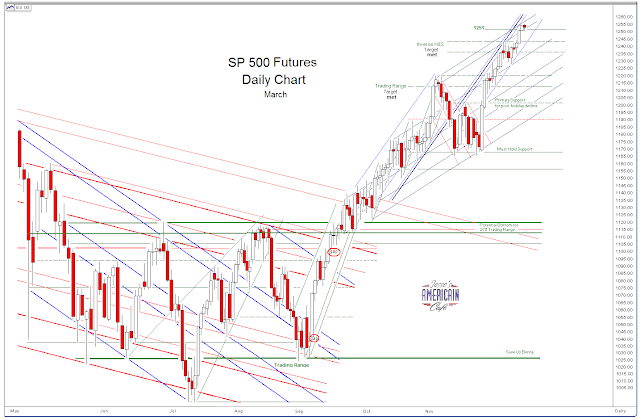skip to main |
skip to sidebar
I started building positions in gold and silver bullion on weakness yesterday and today, hedging them with short stocks positions and long volatility in the VIX.
As of today, the adults have left the building and the kids are managing the desks. So I do not expect anything profound before January unless there is some exogenous development. Volumes are thin and liquidity is plentiful.
A massive shift in fund flows has been underway among individual investors since the 'flash crash' as they flee US bond and equity funds in favor of offshore investments, gold, silver, and other commodities.
Charles Biderman, CEO of TrimTabs Investment Research, has the details and a theory that QE2 is supplying the liquidity to support US stocks at artificially high prices. Biderman says that the government is 'rigging the market.' He wonders what will happen when this monetary support falters. I myself wonder if the TBTF banks are using the Fed monies to build up assets in a pyramid scheme that will do further damage to institutional monies like 401k, insurance, and pension funds. Typically in Ponzi schemes there is a violent market correction back to a sustainable equilibrium.
Could Wall Street peddle fraudulent instruments and cause serious damage to the real economy in order to line their own pockets with fees and bonuses while the government and regulators look the other way?
Uh, how do you think you got here in the first place? Nothing has really changed as a consequence of the failure to reform and allow the system to take its losses. All the individual can do in such an environment of insider trading and artificial pricing is to protect themselves, which is what it appears many individual US investors are doing by shunning US funny money paper and placing their wealth in safer investments overseas, in commodities, and precious metals if Mr. Biderman has his facts straight.
Yes, there is plenty of short term, high risk, cynical money to be made in US equities as in any pyramid scheme while it is building. But one has to know when to get out with a profit. It will be hard to beat the pros to the exits when the time comes.
Following the Fund Flows - Charles Biderman of TrimTabs on CNBC
Airtime: Thurs. Dec. 23 2010 | 4:13 PM ET
So let's see what happens.
See my Handwave Forecast for 2011 for a look ahead.


Here is a brief excerpt from a book describing the Weimar hyperinflation which I came across today. It reminded me of the collapse of the Russian rouble during the dissolution of the Soviet Union. I was there when the rouble was still being used but the writing was clearly on the wall. There were terrible shortages of basic goods such as toilet paper, cigarettes, and common foodstuffs. Water and electricity were marginally reliable. Since most housing was supplied by the state there were few homeless in evidence, but plenty of quiet desperation and going through the motions of daily life.
Foreign corporations with domestic operations were sitting on huge piles of depreciating currency which they were unable to expatriate or convert. People were desperately trying to obtain hard currencies, and durable goods like diamonds, gold, and silver. Most of the popular places such as 'the world's largest McDonalds,' Lenin's Tomb, and GUM Department Store were almost deserted.
I brought home quite a few 500 and 1000 rouble notes for the children to play with, which I received on exchange with the office staff for US dollars as a courtesy to them. The unofficial exchange rate was 300 to 1 but really no one wanted to exchange, and the economy had shifted to hard currencies and barter, or nothing.
Every morning our fellows scheduled working meetings with some of the local staff at the hotel which had a breakfast buffet. We really did not have anything to discuss, but they were grateful for the opportunity to eat their fill for the start of the day. The expats were living reasonably well since they were paid in dollars, but they were impacted by the shortages and personal insecurity.
The rouble was finally reissued as the 'new rouble' in January 1998 at the rate of 1000 to 1 for the old rouble. This is probably a more realistic example to keep in mind than the example from Weimar below.
On January 2, 1924 the full implications of the Austrian currency reforms dawned upon her:
"The kronen and heller have been changed into schillings and groschen.* (Their issue in silver and copper coins rather than paper was to encourage thrift and restore confidence. The change of style was to get rid of large figures.) It is a drastic change. For 15,000 kronen we get — one schilling! Thousands of Austrians have been reduced during the last days to beggary. All who were not clever enough to hoard the forbidden stable currencies or gold have, without exception, suffered losses. An old married couple with whom I have been friendly for years had a holding of government stock amounting to 2 million pre-war kronen which brought them in interest 80,000 pre-war kronen a year [more than £3,200]. They were rich people. Today their stock brings them in 8 new schillings a year. Panic has seized the Stock Exchange. My millions have dwindled to about a thousand new schillings. We belong to the new poor. The middle class has been reduced to the proletariate.…"
Adam Fergusson, When Money Dies, p.131


































